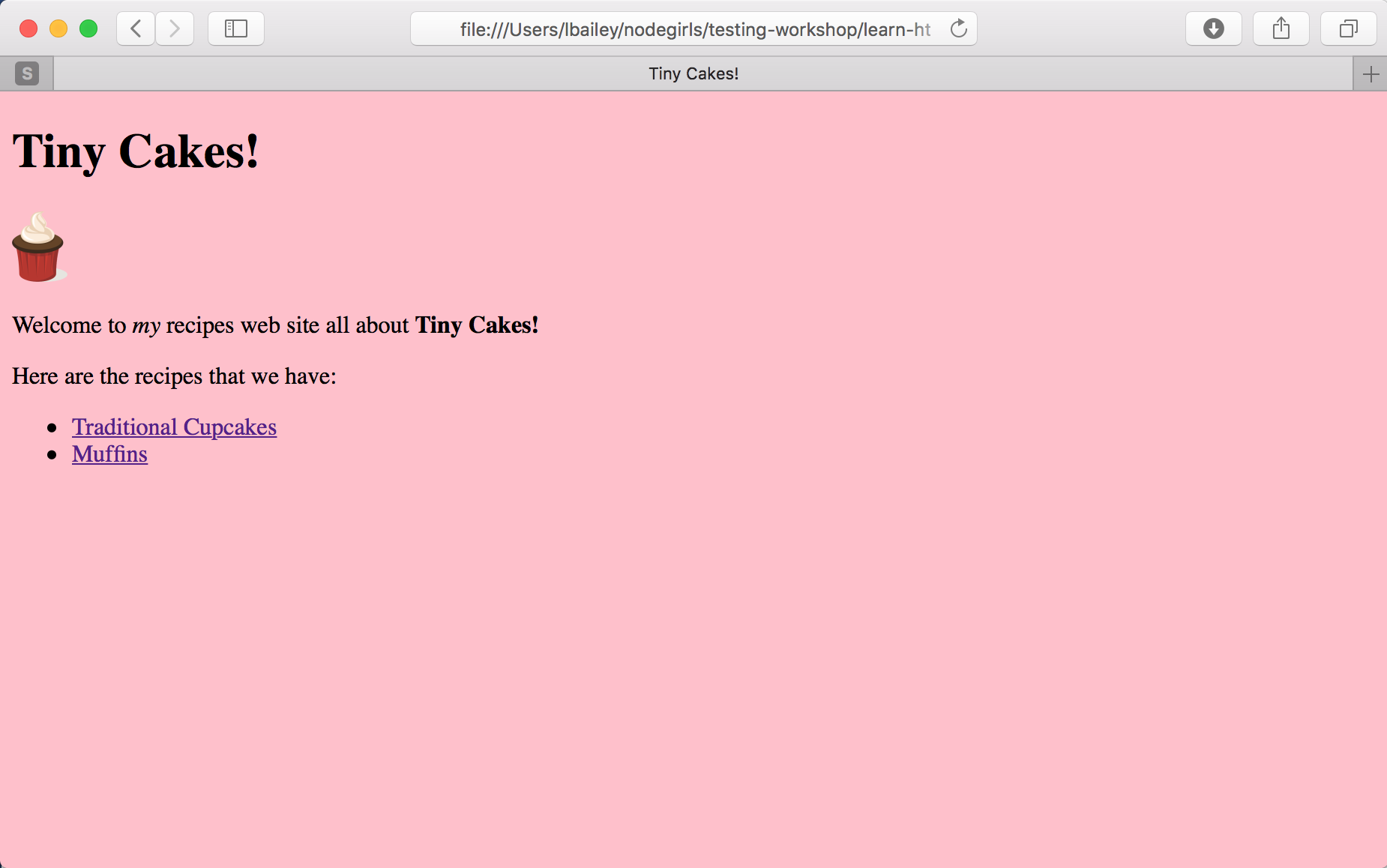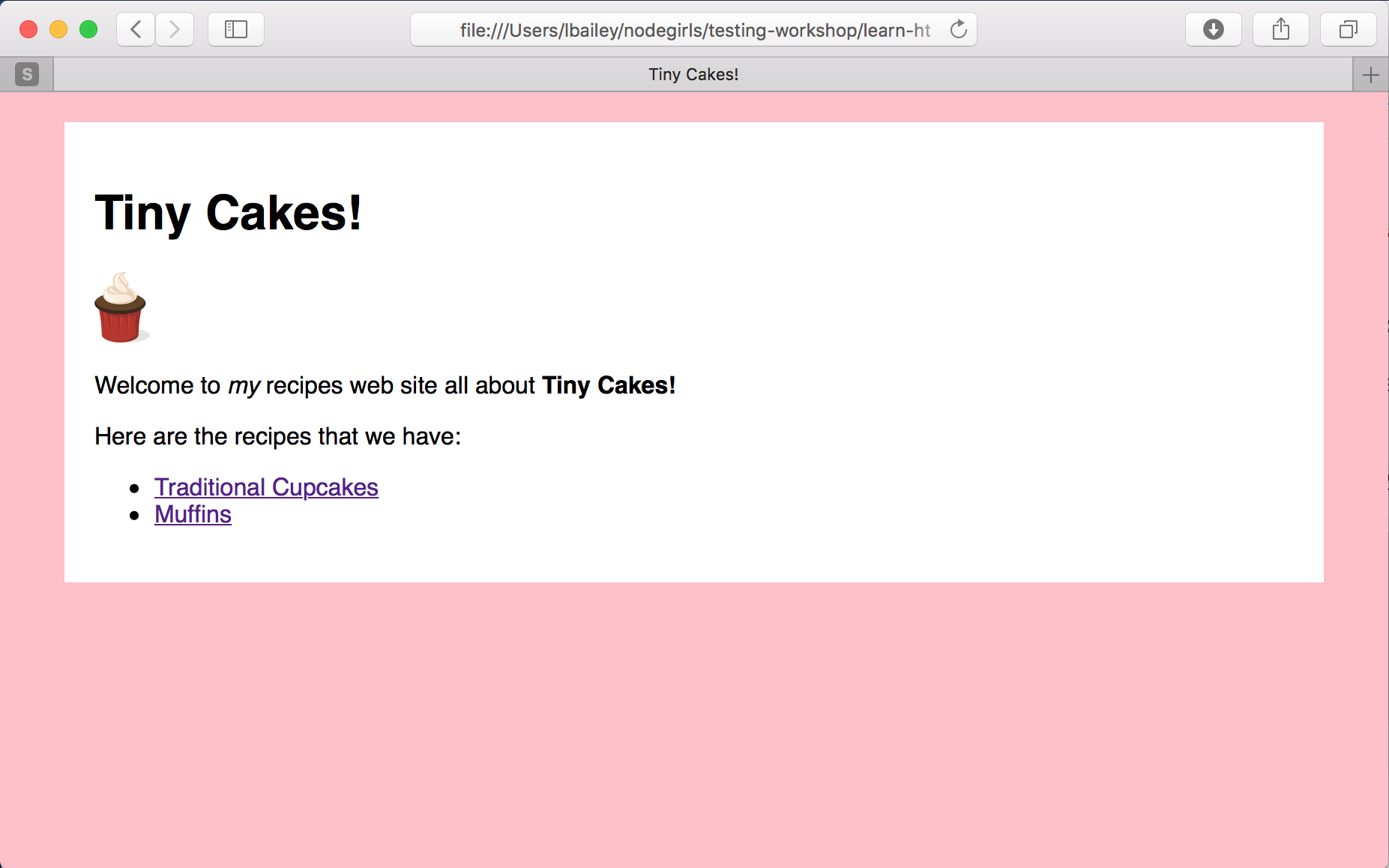Workshop Steps
- 0 - What is the Web?
- 1 - Tools of the Trade
- 2 - Get Setup
- 3 - Marking it up
- 4 - Formatting the Homepage
- 5 - Formatting Recipes
- 6 - Images
- 7 - Stylin' with CSS
- 8 - CSS Selectors
- 9 - Styling Links
- 10 - div and span
- 11 - And What Now?
Useful Links
Step 7 - Stylin' with CSS
So far our pages look pretty plain. This is because we haven’t specified any styles for them.
When you don’t specify any styles, the browser uses its default style for the “look” of the page. Most browsers use pretty similar default styles.
The system used by webpages to specify styles is called Cascading Style Sheets or CSS.
Let’s create some simple styles for our pages.
Create a new file called tinycakes.css with the following content:
html {
background-color: pink;
}
Note the American spelling of colour.
Now edit index.html and each of the recipe pages & add the following line inside the <head> section of each page.
<link rel="stylesheet" href="tinycakes.css" />
So for example index.html would have a <head> that looks like:
<head>
<title>Tiny Cakes!</title>
<link rel="stylesheet" href="tinycakes.css" />
</head>
Refresh the page and it should now have a lovely pink background.

The <link> tag tells the page to use tinycakes.css as a stylesheet.
Stylesheets are made up of one or more styles. A style is made up of a selector and a list of style declarations surrounded by braces. Each declaration must have a semicolon at the end.
The selector specifies what elements the style applies to.
The declarations specify the style properties of the elements to set and what value to set them to.
In our example, the selector is html and the single declaration is background-color: pink.
This obviously sets the background colour of the html element to pink.
There are many style properties that you can set on each element. You can find a full list of them and how they can be used here: https://developer.mozilla.org/en-US/docs/Web/CSS/Reference
About Colours
There are three different ways you can specify a colour:
- By using a colour keyword:
pinkis pink - By using functional notation:
rgb(255, 192, 203)is pink - By using hexadecimal (HEX) notation:
#ffc0cbis also pink.
The functional notation uses three values, one for red, one for green, and one for blue, AKA RGB values.
The values are from 0 to 255.
There is also a rgba version of this where you can specify a fourth value, a percentage to represent transparency (or alpha value).
The hexadecimal notation has a # character followed by three numbers in hexadecimal format to represent the same three red, green, and blue values.
Many graphics apps will let you pick a colour and get the hexadecimal or RGB values for it. If you Google for colour pickers you will find many apps and web apps that let you do this too.
There is good documentation on colour values here: https://developer.mozilla.org/en-US/docs/Web/CSS/color_value
Let’s add a style for <body>.
Add the following to tinycakes.css after the html style.
body {
background-color: white;
max-width: 800px;
margin: 20px auto;
padding: 20px;
font-family: sans-serif;
}
Refresh our page. That looks a bit nicer. Lets have a look at what we did.

- We set the background color to white.
- We set the maximum width of the body to 800 pixels. By default
<body>will have a width of 100% because it is a block element. Settingmax-widthmeans it will still try to be 100% but will never go wider than 800px. - We use the
marginproperty to set the top and bottom margins to20pxand the left and right margins toauto. Themarginproperty is the space around an element.automeans it will make both left and right margins equal to the width of the page minus the width of the element. This effectively centers the element. Try re-sizing the browser window to see this effect. - We set
paddingto20px. Padding is the space between the outer edge of the element and its content. - We specified a sans serif font for the text. By default most browsers use a serif font. We could have also named a specific font, like “Times New Roman” or “Courier”, but if that font doesn’t exist on the user’s machine then their browser will just use its default font anyway.
Now that we’ve seen some more examples of style properties let’s go to the next step and examine selectors more carefully.
 Muses Code
Muses Code